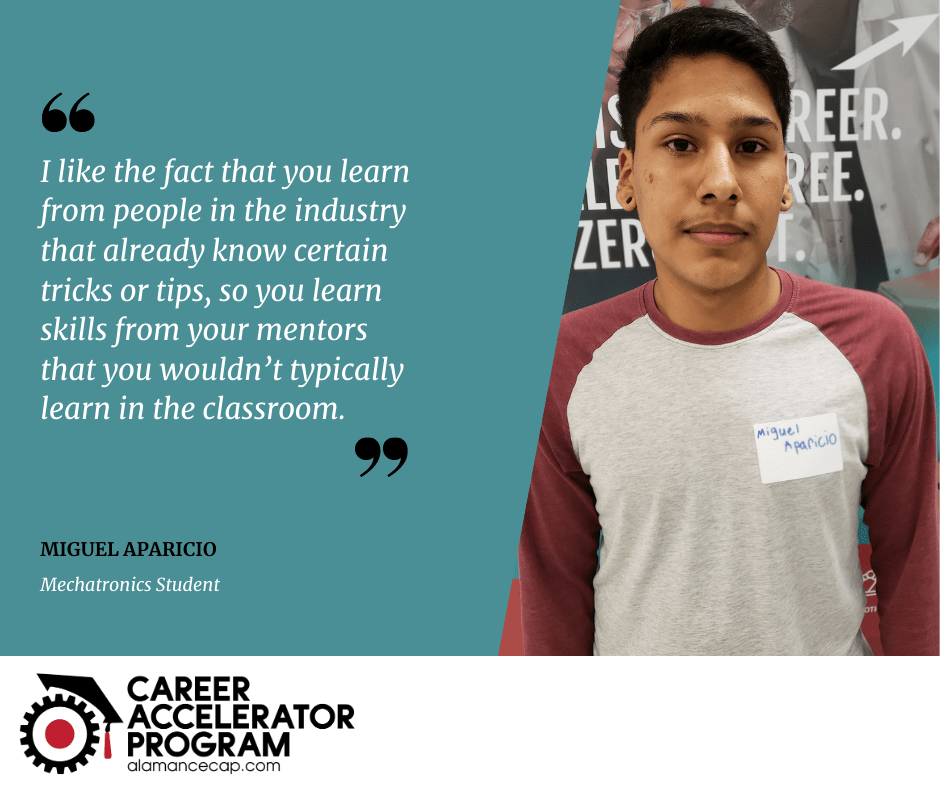By: Jack O’Grady
The Client
The Career Accelerator Program (CAP) is a revolutionary partnership between Alamance Community College (ACC), the Alamance Chamber of Commerce and local Alamance County businesses, designed to further the careers of talented students.
Challenging the typical four-year college model, which often saddles students with debt without preparing them for real-world job demands, CAP focuses instead on developing students’ on-the-job skills by literally paying them to go to school and get a job.
Students accepted into CAP split their time between attending classes at ACC and apprenticing at a local manufacturer. CAP apprentices end their four-year experience with a free degree and 8,000 hours of paid on-the-job experience. It’s an innovative approach to education that benefits both students and employers.
The Problem
In many of the interviews conducted with CAP apprentices, when asked about their thoughts about CAP before joining the program they said it seemed “too good to be true.” This is CAP’s main marketing obstacle – a general lack of knowledge and trust of alternatives to traditional college that has led to an ingrained bias.
With its first apprentices signing on to the program in 2016, CAP is still a new offering looking to establish itself as an equally viable option to a traditional four-year college. While CAP’s apprentice cohort has grown since the first three signed on, supporting consistent expansion has become the main concern.
For many students, the idea of taking up an apprenticeship over going to college just doesn’t cross their mind. They may not even know what an apprenticeship really is, or view it as “too good to be true” and pass up on an amazing opportunity.
Therefore, effectively communicating the differences between an apprenticeship and a traditional college education, including why an apprenticeship may work better for certain students, was a top priority for CAP going into our partnership.
We were tackling a lack of market awareness about both CAP and the entire concept of on-the-job education. Our goal was to take the misplaced notion of apprenticeships as “less than” post-high school paths, and elevate them to an equally viable option that students interested in a technical field would consider from the start.
The Strategy
To establish CAP as a viable alternative to four-year colleges and increase students’ understanding of apprenticeships, we turned to the current cohort of CAP apprentices.
Our strategy followed the idea that the best people to tell the story of CAP were the students who’d enrolled in the program and seen its unique benefits for themselves. We believed other students would be more open to messages from their peers than from educators or marketers, and that the personal stories of CAP apprentices were compelling in their own right.
We wanted our strategy to fit CAP’s overall mission of empowering its apprentices with real-life skills, and thought that involving them in the marketing process would provide them with storytelling and personal branding skills.
Put into action, this strategy breaks down into a series of feature profiles written by 1893 Brand Studio copywriters about CAP apprentices and published to CAP’s blog. We also set up social media training sessions with CAP apprentices, where 1893 Brand Studio representatives educated them on how to effectively use Facebook, Instagram, and LinkedIn to further their own careers and promote CAP to others.

Each feature profile written for this project focused on a single CAP apprentice, telling the story of what brought them to CAP and what they’ve learned from their experience. Individual interviews were set up with every CAP apprentice who volunteered for the project, and interviewers were given a set of required questions along with the freedom to go off-script in order to get more of the story.
We chose to approach these profiles like reporters writing a feature story, opening up options for more creative and personal profiles that truly captured each students’ journey.

The social media trainings we organized were split into beginner and intermediate sections based on experience, and showed students how to make the most of their social media for themselves and CAP. Focusing on Facebook, Instagram, and LinkedIn, the trainings also included important tips for using social media as a professional and a list of resources for enhancing social media posts.
The Outcome
The profiles our team of copywriters put together are now publishing on the CAP blog, with promotion on their social media.
Visitors to the CAP website will now have an exhaustive set of in-depth student testimonials to help guide their decision and illuminate the apprenticeship experience. The promotion of each profile on social media will help to spread the word about the effectiveness of apprenticeship programs like CAP and contribute to the changing narrative around post-high school education.

